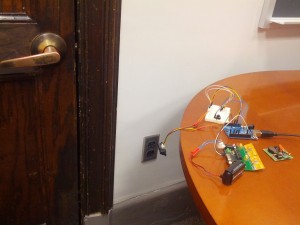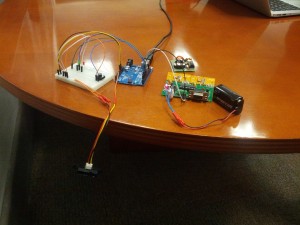The Elite Four (#19)
Jae (jyltwo)
Clay (cwhetung)
Jeff (jasnyder)
Michael (menewman)
Project Summary
We will develop a minimally intrusive system to ensure that users remember to bring important items with them when they leave their residences; the system will also help users locate lost tagged items, either in their room or in the world at large.
Supported Tasks
In this prototype there are three tasks that we have implemented. The first task (easy) is to identify when a door has been opened and alert the user if s/he tries to leave without tagged item(s). The second task (medium) is for the system to help the user locate lost tagged items in his/her own room. Our final task (hard) is to help the user locate lost tagged items outside of his/her room. This task is very similar to the second from the system’s point of view, but for the user it is far more difficult, since the potential location of the lost item(s) is much greater.
Changes to Tasks
We considered changing the tasks to focus on the first goal of our system: making sure the user doesn’t forget important items when leaving home. In the end, however, this change seemed fairly meaningless, since that’s all encompassed within our first task. Feedback from P4 did not reveal any reason to seriously change the tasks, so we ultimately decided to leave them as is.
Thus, the same storyboards we used in P2 are still applicable.
The design itself has changed a little from the sketches, mostly because we now have a more concrete idea of what the parts look like and how they work and interact. Functionally, however, the design is still mostly the same (minus syncing), and any minor changes in appearance can be seen in the photos/video below.
Revised Interface Design
Our prototype’s interface currently lacks syncing capability — we deemed it unnecessary and impractical for a system that currently only has a single tag. Otherwise, the user interacts with the prototype in much the same way as previously specified — the device sits near the door and flashes a warning LED if it detects a door being opened without important objects in close proximity. For item-finding, the user press a button that switches to item-finding mode, then moves the device around, gauging distance to the missing tag by the frequency of the LED’s blinking.
Overview and Discussion
For our working prototype, we were able to implement the core features of our system. For task one, this functionality consists of recognizing a door being opened and either alerting the user if they have forgotten their tagged items or giving them the go-ahead to leave their room. For now, these alerts take the form of differently colored LEDs. For tasks two and three, the functionality consists of being able to walk around with the system and see changes in frequency of LED flashing based on proximity to the tagged items.
For our prototype, we left out the syncing feature, which would allow the user to sync their tags to the device and have some way of knowing which device is missing. This is mostly a practical decision, as we currently only have a single active RFID tag (due to cost), but the functionality would be quite useful if our system used multiple tags simultaneously.
Currently, the prototype is fairly rough. The “door-mounted” mode is not actually door-mounted, and we haven’t yet moved to battery power only for the entire device (a necessity for practically implementing tasks two and three). For the search mode, since we haven’t yet neatly encapsulated the prototype into a single chassis, it’s fairly awkward to carry it around. We had some difficulty with attempts to produce sound, but we hope to resolve this for future prototypes. Despite all of this, however, we were able to successfully complete our outlined tasks.
No wizard-of-oz techniques were used in this prototype. In addition, no outside code was used in this prototype.
Video and Images

The “door-mounted” version of our prototype, which detects when the door is opened and alerts the user if tagged items are nearby or missing.

The door-mounted version of the prototype from another angle. You can see the infrared sensor (which detects the door opening) dangling off the table.

The device affixed to a board for mobility. This allows it to be carried around for tasks 2 and 3, which involve finding lost tagged items.
This video demonstrates our prototype’s ability to perform task 1, alerting the user when tagged items are left behind.
This video demonstrates our prototype’s ability to perform tasks 2 and 3, finding lost tagged items. Note that from the system’s perspective, these tasks are quite similar, so only a single video is provided.
